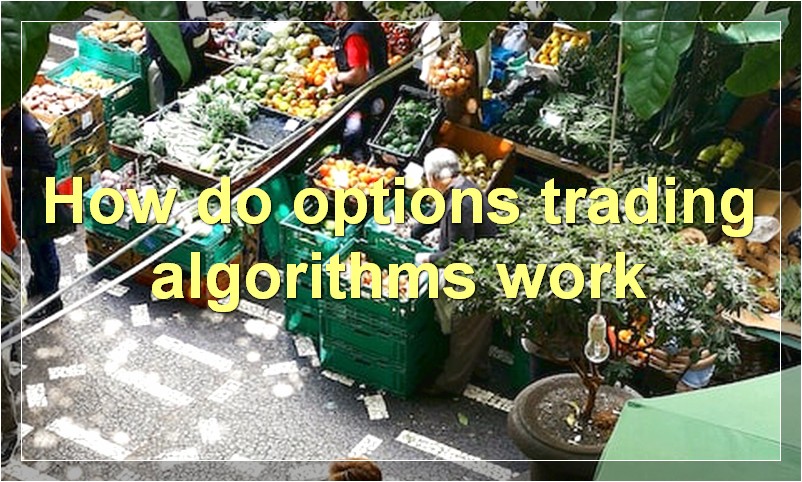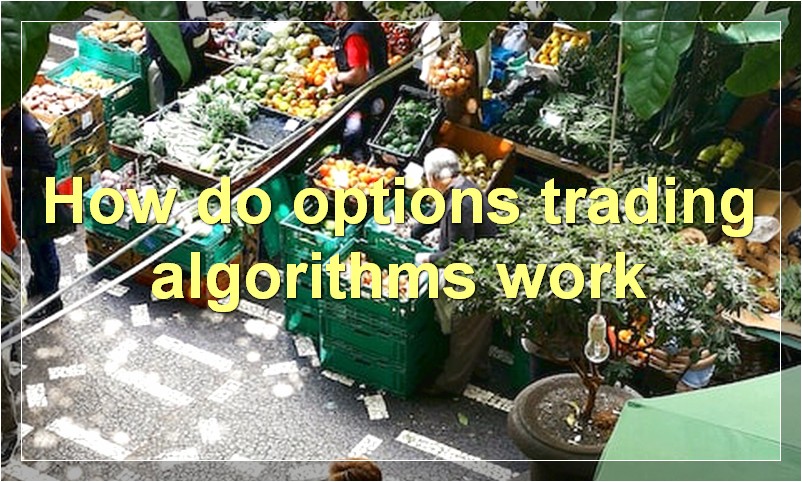If you’re looking to get started in options trading, then this comprehensive guide is for you. We’ll walk you through everything you need to know about algorithms, including how they can help you make better trades.
What are some common options trading algorithms
There are many different options trading algorithms available to traders. Some common options trading algorithms include:
1. The covered call algorithm.
2. The collar algorithm.
3. The straddle algorithm.
4. The synthetic put algorithm.
5. The iron condor algorithm.
Each of these algorithms has its own unique set of rules and tradeoffs. Traders need to carefully consider which algorithm best suits their trading style and risk tolerance.
How do options trading algorithms work

Algorithmic trading, or “algos”, are computer programs that trade based on predetermined conditions. These conditions can be based on timing, price, quantity or any mathematical model.
Options trading algorithms work by taking into account the underlying security, the option’s strike price and expiration date, the volatility of the underlying security and the risk-free interest rate. Based on this information, the algorithm will determine whether to buy or sell the option.
The advantage of using an algorithm to trade options is that it can take into account a large number of factors in a short amount of time. This allows for more accurate decision-making and can help to take emotion out of the equation.
If you’re interested in trying out algorithmic trading, there are a number of online platforms that offer this service.
What are the benefits of using an options trading algorithm
An options trading algorithm is a computer program that automates the process of buying and selling options.
The benefits of using an options trading algorithm include the ability to:
1. Quickly and efficiently identify market opportunities
2. Automate the buying and selling process
3. Backtest trading strategies
4. Stay disciplined and emotionless when trading
5. Potentially increase profits
What are the risks associated with options trading algorithms
When it comes to options trading, there are a number of risks associated with algorithms. One of the biggest risks is that an algorithm can malfunction and cause trades to be executed at the wrong time or price. This can lead to significant losses for the trader. Additionally, algorithms can be subject to market manipulation by participants with malicious intent. Finally, if a trading algorithm is not well-designed, it can result in sub-optimal results for the trader.
What are some common features of options trading algorithms
Some common features of options trading algorithms include the ability to automate the process of buying and selling options contracts, as well as the ability to back-test different options strategies before implementing them in live trading. Additionally, options trading algorithms often provide traders with real-time market data and analysis, which can help them make more informed decisions about when to buy or sell options contracts.
How do options trading algorithms impact the markets

In recent years, the rise of algorithmic trading has had a profound impact on the markets. These days, a significant portion of all trading is done by computers following pre-determined rules or algorithms. This has led to increased market efficiency and liquidity, as well as lower transaction costs.
However, some have raised concerns that algorithmic trading may be destabilizing the markets. For example, if a large number of traders are using the same algorithm, it could lead to all of them buying or selling at the same time, which could create artificially high or low prices. Additionally, algorithms can be programmed to react to certain events in a very short timeframe, which could lead to sudden and drastic changes in prices.
Overall, algorithmic trading has had a positive impact on the markets. However, it is important to monitor how these algorithms are used and to make sure that they are not being abused.
What are the regulatory requirements for options trading algorithms
There are a few regulatory requirements for options trading algorithms. First, the algorithm must be registered with the SEC as a broker-dealer. Second, the algorithm must comply with FINRA’s rules and regulations. Third, the algorithm must meet the requirements of the Commodity Futures Trading Commission (CFTC). Fourth, the algorithm must be designed to handle the risk associated with options trading. Finally, the algorithm must be tested and approved by the exchanges on which it will trade.
What are the challenges involved in developing options trading algorithms
One challenge in developing options trading algorithms is accounting for the time value of money. This is because options contracts are derivative securities, meaning their value is derived from the underlying asset. The time value of money is the concept that money today is worth more than money in the future. This is because money can be invested and earn interest, so it is worth more than money that will not be received until a later date. When valuing options, accountants must take into account the time value of money to ensure they are accurate.
Another challenge in developing options trading algorithms is dealing with volatility. Volatility is a measure of how much the price of an asset fluctuates. Assets with high volatility are more risky, but also have the potential for higher returns. When developing algorithms for options trading, traders must take into account the volatility of the underlying asset in order to make accurate predictions.
What is the future of options trading algorithms
The future of options trading algorithms is shrouded in mystery. Some believe that they will continue to evolve and become more sophisticated, while others believe that they will be replaced by more traditional methods of trading. Only time will tell what the future holds for options trading algorithms.
How can I learn more about options trading algorithms
If you want to learn more about options trading algorithms, a good place to start is by reading books on the subject. There are many different books available that can provide you with a basic understanding of how these algorithms work. Additionally, there are online courses and tutorials that can teach you the basics of options trading algorithms. Finally, you can also speak with a financial advisor to get more information on this topic.

